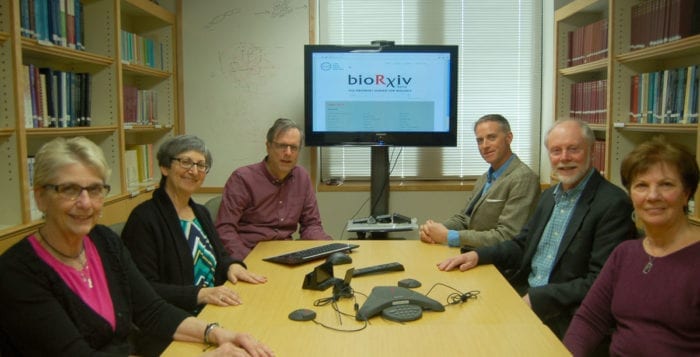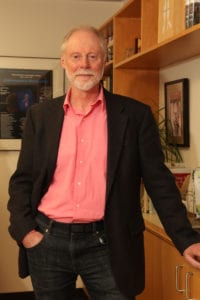When a scientist has to have a colleague’s research right now, there’s bioRxiv

In 1933, a gathering of scientists took place at Cold Spring Harbor Laboratory. The symposium, which started a tradition that continues today, resulted in the publication of a book.
With that book, CSHL started a publishing arm that now includes eight journals and over 200 books. One of the newer efforts is open to a scientific and worldwide audience for free. Created in 2013, bioRxiv (pronounced “bio-archive”) is a preprint service designed to share cutting edge and unedited biological and scientific information by posting manuscripts on its website.
The service, which has been growing rapidly and is supported by the Lourie Foundation and CSHL, had approximately 400,000 page views and 185,000 downloads in March.
“BioRxiv offers scientists the chance to share their work with colleagues who can make their own, often expert assessment of the work that’s been done without waiting for the often lengthy process of peer review,” said John Inglis, executive director and publisher at CSHL Press and one of the co-founders of bioRxiv, along with Richard Sever, who is the assistant director at CSHL Press.
Indeed, in September 2015, two prominent cardiologists made a public argument, through the New York Times Op-Ed pages, that information in clinical trials, particularly those that may alter the course of treatment for patients, should be made available as soon as possible.
The traditional publication process, which involves preparing data, presenting graphics and sending information to journals for peer review, can take months or more. Eric Topol, a cardiologist at the Scripps Clinic and Harlan Krumholz, a cardiologist at Yale-New Haven Hospital, suggested that this data should be on a National Institute of Health website or published on a preprint platform, such as bioRxiv.
“A very large number of clinical trials are open and then closed for various reasons,” said Inglis. “They thought it was a good idea and we now have that category.”

and one of the co-founders of BioRxiv. Photo by Gina Motisi / Cold Spring Harbor Laboratory
BioRxiv, which provides a preprint service for scientists in categories ranging from animal behavior and cognition to biochemistry, biophysics, neuroscience and zoology, also recently developed a section for epidemiology. That, Inglis said, is as far as the CSHL preprint service is prepared to go into clinical medicine at this point.
Modeled after a similar preprinting effort called arXiv that is hosted by Cornell University for physics, math, computer science and related disciplines, not only can bioRxiv provide scientists with a way to share information more rapidly, but it can also serve as a forum to share incremental pieces of information or a negative result.
In Gholson Lyon’s case, the preprint service, which is housed in the same building where he works, helped him find doctors around the world.
An assistant professor, Lyon had worked with two boys with intellectual disability and who had unusual facial characteristics. After screening their genes, he searched for others who might have the same undiagnosed condition.
Preprinting on bioRxiv helped him find doctors in Colombia, Mexico, France, Germany and the United Kingdom who had patients with similar symptoms. BioRxiv expedited the pace of scientific discovery, Lyon said.
Steven Shea, an associate professor at CSHL, used bioRxiv because of the slow pace of the review process.
“We wanted [the work] to see the light of day,” Shea said. Shea believes more scientists can and should share their results on the website.
While bioRxiv offers a preprinting service, it doesn’t aim to replace peer-reviewed journals, Inglis said. Rather, it is a quicker step between the bench and the scientific community.
BioRxiv has been growing rapidly, particularly in the last few months. According to Inglis, between May and December of 2015, the rate of submissions doubled. The pace of submissions picked up even before a high profile Accelerating Science and Publication in Biology (ASAPbio) meeting in February.
To be sure, the site still posts a small percentage of the scientific information published in its fields.
Early on, Inglis said some journals resisted preprints. Not only has that number dwindled, but eight scientific publications have become a part of a pilot process that allows scientists to submit manuscripts directly through bioRxiv. He expects that number to climb to 20 by the end of April.
Unlike with peer-reviewed journals like Lancet, where Inglis started his scientific publishing career, bioRxiv does not provide editing or content review services. Each post includes a mention at the top that it is a preprint and has not been peer-reviewed.
CSHL makes sure the posts aren’t spam. Before they share the manuscripts with the public, they put them in a queue, where a group of 40 scientists make sure they really are science.
BioRxiv declines submissions that are out of the scope of its publishing interests or that are term papers, theses or unsubstantiated hypotheses, which is fewer than 5 percent of the submissions, Inglis said.
Authors can revise their manuscripts on the site, which has occurred about 30 percent of the time, Inglis said.
A native of Aberdeen, Scotland, Inglis met with CSHL’s former CEO James Watson, who approached him about joining the institution. A few months before Inglis arrived, CSHL had launched its first journal.
When Inglis arrived in 1987, he and his wife Lesley, who has been teaching English as a second language at CSHL for nine years, said they expected to have “an adventure for a few years” and then return to the United Kingdom with their sons, who were in middle school. Adam now lives in Arlington, Massachusetts, with his wife Lizzie and their two sons and Tony and his wife Louise live in Brooklyn.
As for bioRxiv, Inglis sees the preprint offering as an approach consistent with the current cultural environment.
The research community includes numerous “young people who have grown up with the internet and all its possibilities,” Inglis said. “They are very comfortable with sharing in general but also with the embrace of technologies that create community across the boundaries of geography, culture, age and status.”






